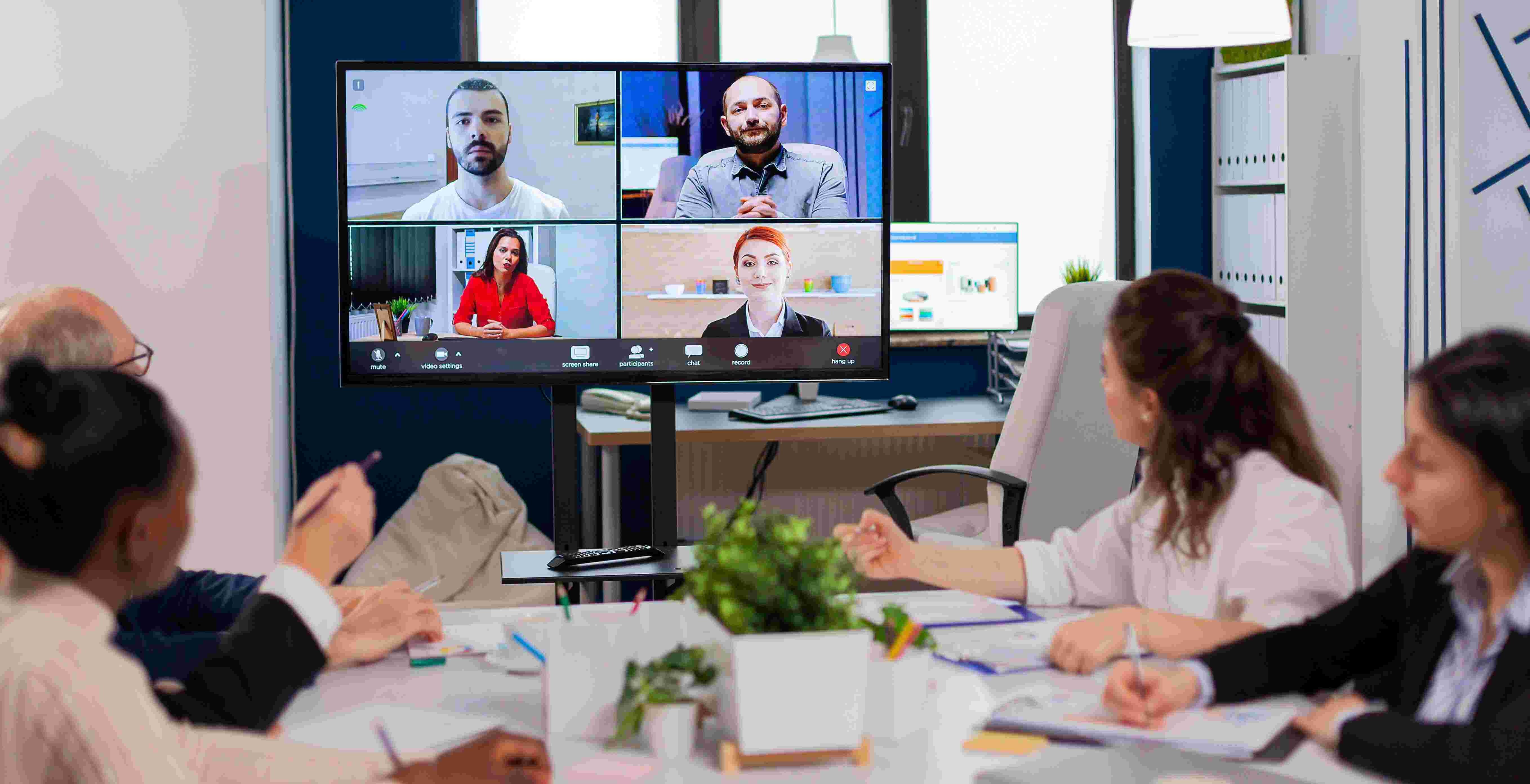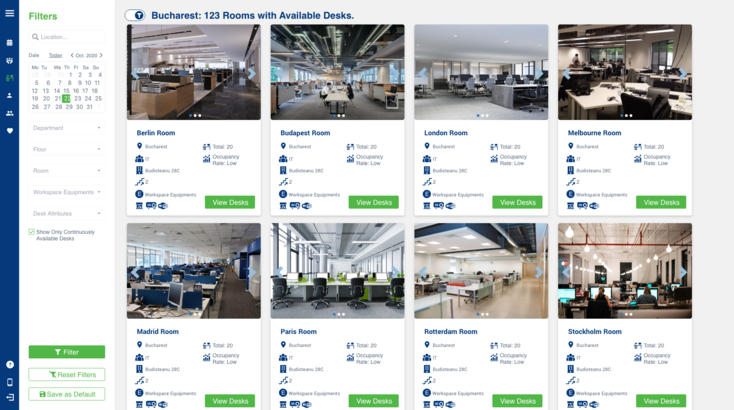The past four years have brought about a significant transformation in our ways of working, marking a great shift from a century of predominantly on-site employment. Today, people are divided, reflecting the increasing preference towards flexible work arrangements. Some people prefer working in the office for social interaction and better collaboration, others prefer a hybrid model that allows them to balance their professional and personal lives more effectively, while the rest prefer working fully remotely for various other reasons, such as lengthy commutes or the cost savings associated with cooking at home and eating in.
Since hybrid work is here to stay, there was never a higher need for office space management systems that benefit both employees and their employers, as we have previously discussed in this article. Let’s take a look at some of the recent statistics regarding the ways of working today, our view on it, as well as what roomio can do to help in this respect.
Recent Work-Related Conversations
Starting January 2, Amazon employees are required to work on-site five days out of five, after CEO Andy Jassy’s announcement in September last year, with mixed reactions from employees. This follows the first implementation of the mandatory three-day return-to-office ruling in May last year. While Amazon is backing up its decision by putting forward the importance of collaboration, teamwork, and innovation, the real reasoning behind it might actually be from an Economics standpoint. Local government tax incentives were offered in the pre-pandemic times for large headquarters in cities like Seattle, and this move might be seen by some as “avoiding tax liabilities.”
While companies such as Spotify, DuckDuckGo, and Atlassian have announced that they remain fully remote forever, others such as Amazon, Dell, Google, and Microsoft have reconsidered their position several times since the end of the pandemic, with Google and Microsoft ultimately deciding not to follow in Amazon’s steps.
All organizations need to consider several factors before deciding on fully on-site, hybrid, or fully remote, so let’s take a look at some important recent statistics regarding employee preferences and overall work environment trends.
Statistics in Work Practices
Hybrid work seems to be the preferred way for many employees, according to several surveys: according to Gallup, over half of U.S. remote-capable employees expect and prefer hybrid work, according to LiveCareer, only 2% of workers prefer fully on-site work over remote or hybrid models, and according to research by Randstad, 37% of workers say they would consider quitting their job if asked to spend more time in the office.
According to Owl Labs, 22% of workers expect a pay increase if they can no longer work hybrid or remotely, giving out one major reason: hybrid workers say they will pay 20% more than in 2023 to work from the office.
However, according to the Randstad’s 2024 Workmonitor, the top two reasons why workers would not accept a job are:
- If it would negatively hinder their work-life balance (57%)
- If it didn’t offer higher pay (55%)
We notice that salary is no longer the main factor in job selection, as 93% of respondents consider pay and work-life balance equally important. The same study by Randstad also found that ambition is no longer viewed conventionally; with over half (51%) saying they would stay in a role they like even if it doesn’t offer opportunities for career growth, while 41% stated their professional ambition is also influenced by factors outside of their job.
According to Owl Labs, workplace stress is generally on the rise for all workers, despite where they are working from, primarily due to burnout and heightened mental health challenges. The pandemic has resulted in individuals being almost constantly connected to their jobs, contributing to a sense of fatigue from being "always on." This could explain why aspects such as work-life balance, flexibility, and skill development are currently at the forefront of discussions regarding the work environment.
Generational Preferences
Generational differences should also be taken into account, as preferences differ from one generation to another.
According to Matsh, most Millennials prefer working from home, while Gen Z are less likely to look for remote jobs. One possible explanation for this might be that Millennials are having children much later than previous generations, making remote work a better option for work-life balance, while Gen Z, who have spent university and early career years at home during the pandemic, might feel the need for more social interaction at the workplace.
Baby Boomers, on the other hand, are less likely to adopt full remote work most probably for various habitual and/or technological aspects. For instance, 51% of Millennials love their hybrid meeting apps and technology, compared to just 17% of Boomers, according to Owl Labs.
Employer Costs Statistics
According to a research paper by Global Workplace Analytics, 60% of employers identify cost savings as a significant benefit to remote work. A survey by IWG from 2023 states that 90% of surveyed CEOs have reduced costs by adopting hybrid working, saving more than 40% on office space and traditional real estate, among other things.
The same survey mentions how 72% of CEOs say their employees are also happier as a result of flexible work, and nearly all CEOs (96%) agree that implementing hybrid working has enhanced their reputation on the market.
This goes to show that organizations can benefit not only from overall cost reductions, but also from increased employee satisfaction.
What Is Our Take on It?
All these are important aspects to take into account for any organization, since providing the right medium for your employees to work in is crucial for their overall efficiency, productivity, and commitment.
While we at eSolutions & roomio remain mainly remote, we do offer the possibility of working at the office, and recommend regular in-office meetings for better collaboration among us. And roomio is the tool that has helped us achieve this with ease of use.
Desk booking, meeting room booking, parking booking, and other features have been beneficial both for us, as employers, and for our employees.
The best tools are the ones that come to be out of necessity and since roomio was built with our specific use case in mind, we can thoroughly vouch for it. We cover some of the benefits for employers (such as reducing costs, built-in reporting, affordability & easy maintenance) here, and for employees (such as ease of use, colleague & team presence, and accessibility) here.
In Conclusion
Each business is different and works towards various goals; similarly, each employee is different and works in their own way, so there is no one-size-fits-all solution. Differences exist even between departments, or between teams in the same department. While some companies decide on a full five-day return-to-office, and others choose to remain fully remote forever, there should be some thought put into what is best for both the company and the employees in order to achieve success going forward.
After going through all these statistics, it seems clear that hybrid work is regarded as the most considerate option out of all, since it allows for enough flexibility but also manages to boost collaboration and communication. With over 34% of workers admitting to posting about their job or employer negatively on social media (increasing to almost 48% for Gen Z), leaders should thoroughly consider what the best next steps are for their own organizations.
In order to implement a successful and well-organized hybrid work environment, roomio might just end up being your best partner in this endeavor, offering a great solution for workplace management.
Why roomio
Whether you need a hot desk app or parking booking software, roomio is there for you. We offer integrated packages that provide our customers with a complete solution with software and/or hardware integration so you can be at ease that your employees can choose the way they want to work, while you have an overview of the used office space.
Who is behind roomio
 eSolutions is a technology company developing integrated, complex, and secure solutions, with a focus on improving the business processes that stand behind the software. With over 20 years of experience in custom software solutions, eSolutions also boasts several off-the-shelf products that have already been tested and used in production by various organizations.
eSolutions is a technology company developing integrated, complex, and secure solutions, with a focus on improving the business processes that stand behind the software. With over 20 years of experience in custom software solutions, eSolutions also boasts several off-the-shelf products that have already been tested and used in production by various organizations.
Roomio is one of these products and is used throughout Europe by various customers and partners, from companies or hotels to retail or medical venues, among which we can name: Carrefour, Regina Maria, Telekom, Crowne Plaza Hotels & Resorts, Capital Plaza Hotel, and more.

